Green AI Infrastructure Market Size 2025-2029
The green ai infrastructure market size is valued to increase by USD 14.65 billion, at a CAGR of 28.4% from 2024 to 2029. Stringent environmental regulations and growing ESG imperatives will drive the green ai infrastructure market.
Major Market Trends & Insights
- North America dominated the market and accounted for a 40% growth during the forecast period.
- By Product - AI optimized servers segment was valued at USD 1.09 billion in 2023
- By End-user - Cloud service providers segment accounted for the largest market revenue share in 2023
Market Size & Forecast
- Market Opportunities: USD 790.03 million
- Market Future Opportunities: USD 14652.50 million
- CAGR from 2024 to 2029 : 28.4%
Market Summary
- The market is experiencing significant growth, driven by stringent environmental regulations and escalating ESG (Environmental, Social, and Governance) imperatives. As the demand for sustainable technology solutions intensifies, liquid cooling is emerging as the new standard for AI infrastructure, offering enhanced energy efficiency and reduced carbon emissions. However, the adoption of green AI infrastructure comes with challenges. The high initial capital expenditure and system complexity necessitate substantial investment and expertise. Despite these hurdles, the market's potential is vast, with numerous opportunities for innovation and growth.
- According to recent reports, The market is projected to reach a value of USD12.3 billion by 2026, underscoring its immense potential for businesses seeking to reduce their carbon footprint and stay competitive in the evolving technological landscape.
What will be the Size of the Green AI Infrastructure Market during the forecast period?
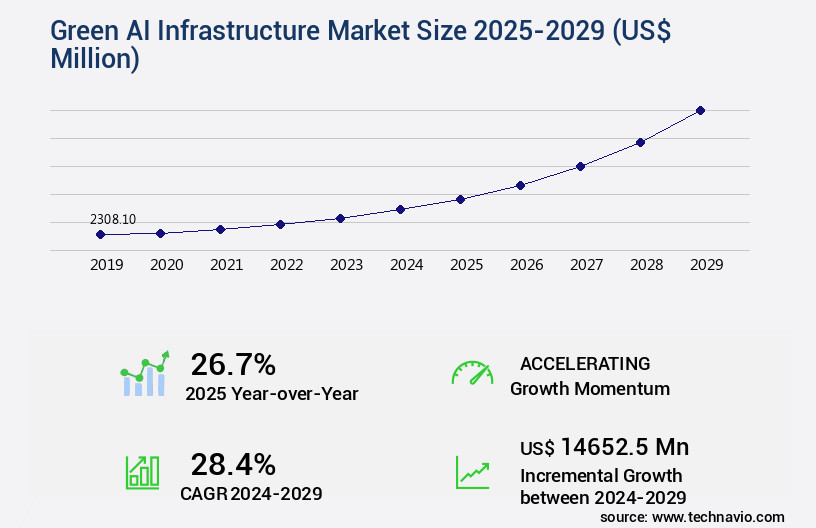
Get Key Insights on Market Forecast (PDF) Request Free Sample
How is the Green AI Infrastructure Market Segmented ?
The green ai infrastructure industry research report provides comprehensive data (region-wise segment analysis), with forecasts and estimates in "USD million" for the period 2025-2029, as well as historical data from 2019-2023 for the following segments.
- Product
- AI optimized servers
- Energy efficient cooling systems
- High performance storage and memory solutions
- Renewable energy integration components
- End-user
- Cloud service providers
- Enterprises
- Government
- Research institutions and AI startups
- Deployment
- Cloud based
- Hybrid and edge-computing environments
- On premises
- Geography
- North America
- Europe
- APAC
- China
- India
- Japan
- South Korea
- South America
- Rest of World (ROW)
By Product Insights
The ai optimized servers segment is estimated to witness significant growth during the forecast period.
The market is witnessing continuous evolution as businesses and organizations integrate IoT devices, implement predictive maintenance models, and adopt precision agriculture systems. Data center optimization, a critical component of this market, is driven by energy efficiency metrics and environmental impact assessments. Cloud computing platforms, green building certification, and real-time monitoring systems are key areas of focus. Drones, AI-powered sensors, and remote sensing technologies facilitate water usage optimization and smart grids integration. The market's emphasis on sustainability is evident in the adoption of renewable energy sources, automated irrigation systems, and sustainable material sourcing. Machine learning algorithms, deep learning applications, and natural language processing are integral to resource management systems and circular economy principles.
Precision fertilizer application, waste reduction strategies, and carbon footprint reduction are essential for eco-friendly operations. According to recent studies, energy-efficient AI servers account for approximately 4% of global electricity usage. These AI-optimized servers, powered by GPUs, TPUs, and ASICs, offer significant energy savings through enhanced parallel processing capabilities. Cybersecurity protocols and edge computing deployment further bolster the market's growth, ensuring secure and efficient data analytics dashboards and soil health improvement. Greenhouse gas emissions are minimized through the integration of computer vision systems, crop yield enhancement, and life cycle assessment tools.
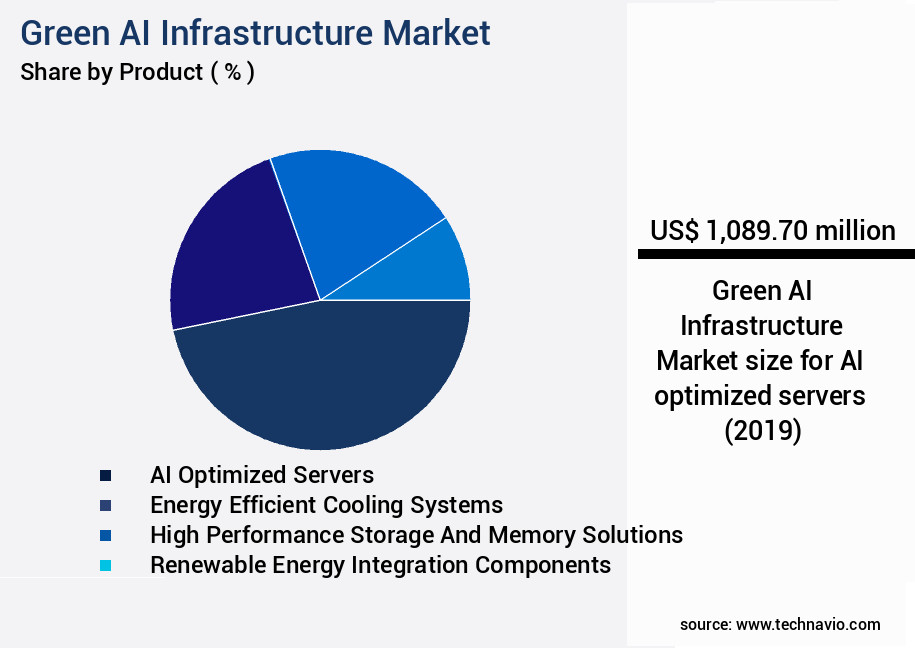
Request Free Sample
The AI optimized servers segment was valued at USD 1.09 billion in 2019 and showed a gradual increase during the forecast period.
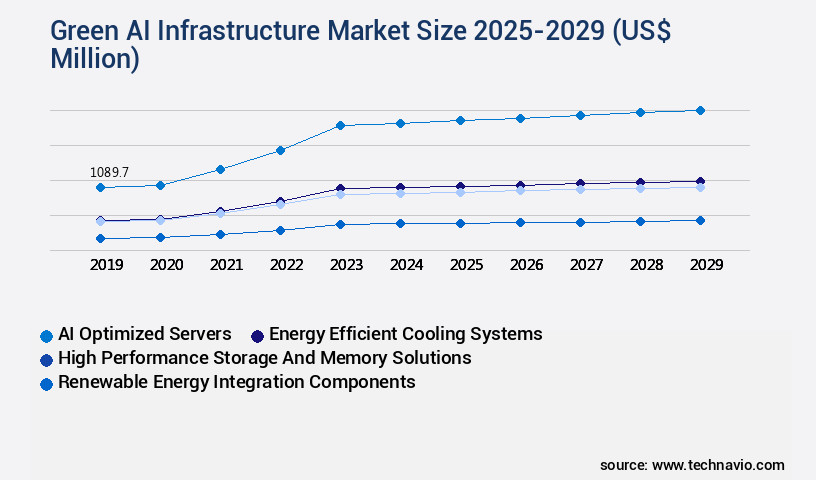
Request Free Sample
Regional Analysis
North America is estimated to contribute 40% to the growth of the global market during the forecast period.Technavio’s analysts have elaborately explained the regional trends and drivers that shape the market during the forecast period.
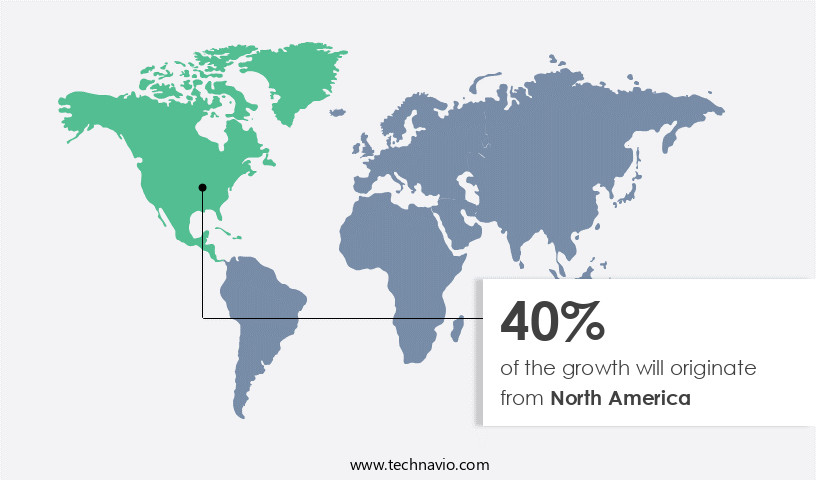
See How Green AI Infrastructure Market Demand is Rising in North America Request Free Sample
The market is witnessing significant evolution, with North America leading the charge. Comprising the United States and Canada, this region is home to a comprehensive ecosystem of market leaders, encompassing semiconductor designers, hyperscale cloud providers, and enterprise software companies. The region's dominance is underpinned by substantial private sector investment and a robust venture capital landscape, fostering innovation in both AI models and energy-efficient hardware. Hyperscalers, such as Microsoft, Google, and Amazon Web Services, are at the forefront of this transition due to the substantial operational expenditure required to power expansive data centers.
To mitigate this expense, they have become pioneers in green infrastructure. According to recent reports, the North American the market is projected to reach over 10 billion dollars by 2026, growing at a remarkable pace compared to other regions. This growth is driven by the region's advanced technological capabilities and the increasing demand for energy-efficient AI solutions.
Market Dynamics
Our researchers analyzed the data with 2024 as the base year, along with the key drivers, trends, and challenges. A holistic analysis of drivers will help companies refine their marketing strategies to gain a competitive advantage.
The market is experiencing significant growth as businesses and governments seek to optimize renewable energy grids using AI-driven solutions. Predictive analytics plays a crucial role in sustainable building design, enabling energy efficiency and reducing carbon emissions. IoT sensor data is harnessed for precision agriculture, enabling machine learning models to conserve water through accurate irrigation and optimize fertilizer application using AI algorithms.
In the realm of water conservation, deep learning algorithms are employed to manage wastewater and monitor water resources in real-time. Real-time monitoring of greenhouse gas emissions is essential for reducing carbon footprints, and remote sensing technologies provide valuable insights into environmental impact. Automated irrigation systems, powered by data analytics dashboards, ensure water efficiency in agriculture and urban landscapes.
Sustainable infrastructure design incorporates life cycle assessment of materials and carbon footprint reduction strategies for data centers. Energy efficiency metrics are vital for smart city infrastructure, which relies on AI for optimizing resource use and ensuring resilient cities. Precision fertilizer application and crop stress detection are achieved through AI-powered sensors, while computer vision systems monitor plant health and growth.
Drone-based monitoring of environmental conditions offers valuable data for managing resources effectively, and edge computing deployment enables real-time data processing. Cloud computing platforms facilitate sustainable data management and cybersecurity protocols protect green infrastructure from potential threats. The future of the market lies in the integration of these advanced technologies to create a more sustainable and efficient world.
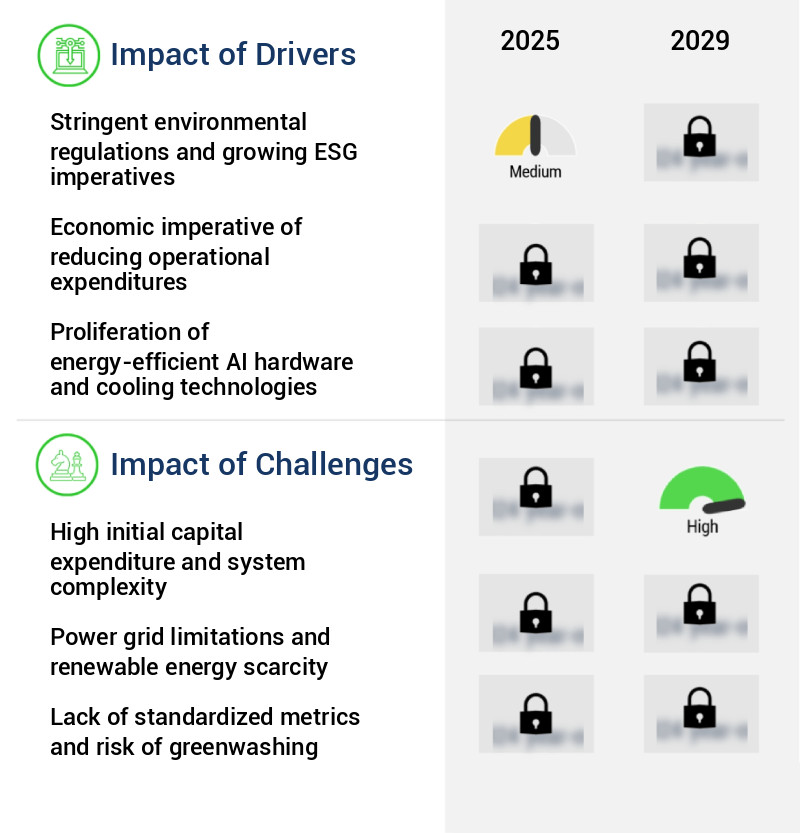
What are the key market drivers leading to the rise in the adoption of Green AI Infrastructure Industry?
- The stringent environmental regulations and increasing emphasis on Environmental, Social, and Governance (ESG) initiatives serve as the primary market driver, influencing businesses to prioritize sustainable practices and adhere to rigorous regulatory standards.
- The market is experiencing significant growth due to the increasing regulatory focus on environmental sustainability and the influence of Environmental, Social, and Governance (ESG) criteria. Governments, particularly in North America and the European Union, are implementing stringent policies such as carbon pricing, emissions trading systems, and mandatory sustainability disclosures, compelling organizations to address their environmental impact. Traditional AI data centers, which consume vast amounts of energy, are under intense scrutiny for their environmental footprint. Failure to comply with these regulations can result in substantial financial penalties, operational restrictions, and reputational damage.
- According to recent studies, the market is projected to grow at an unprecedented rate, with renewable energy sources, energy-efficient hardware, and carbon offsetting strategies becoming increasingly popular solutions. Organizations are recognizing the importance of reducing their carbon footprint and adopting green AI infrastructure to remain competitive and socially responsible.
What are the market trends shaping the Green AI Infrastructure Industry?
- Liquid cooling is emerging as the new market standard for ascendancy. This trend is mandatory for advanced cooling solutions in technology industries.
- The market is experiencing a significant transformation, with the adoption of advanced liquid cooling solutions gaining momentum as the preferred thermal management strategy for high-density computation. Traditional air cooling, which utilizes computer room air conditioners and handlers to circulate chilled air, has been the go-to method for managing IT equipment heat for years. However, the emergence of new-generation AI accelerators, specifically GPUs with Thermal Design Power ratings surpassing 700 watts and nearing 1000 watts per chip, has rendered conventional air cooling methods insufficient and economically unsustainable.
- The thermal density of modern AI server racks necessitates more effective heat dissipation, making it impractical to rely solely on air cooling without excessive energy consumption.
What challenges does the Green AI Infrastructure Industry face during its growth?
- The high initial capital expenditure and complex system requirements pose a significant challenge to the growth of the industry, necessitating substantial investments and intricate solutions.
- Green AI infrastructure, characterized by energy-efficient components like direct-to-chip cooling, immersion liquid cooling, high-efficiency power supply units, and power-optimized AI accelerators, represents a significant investment for organizations. These advanced solutions command a premium price compared to traditional systems. For new data center constructions, the upfront costs are substantial. However, the challenge intensifies for enterprises looking to retrofit legacy data centers, which were designed around air cooling, to accommodate advanced liquid cooling systems.
- The intricacy and disruption involved in such a transition make the investment a formidable undertaking. Despite the initial financial hurdle, the benefits of green AI infrastructure, including reduced energy consumption and carbon footprint, make it an attractive long-term investment for industries such as healthcare, finance, and manufacturing.
Exclusive Technavio Analysis on Customer Landscape
The green ai infrastructure market forecasting report includes the adoption lifecycle of the market, covering from the innovator’s stage to the laggard’s stage. It focuses on adoption rates in different regions based on penetration. Furthermore, the green ai infrastructure market report also includes key purchase criteria and drivers of price sensitivity to help companies evaluate and develop their market growth analysis strategies.
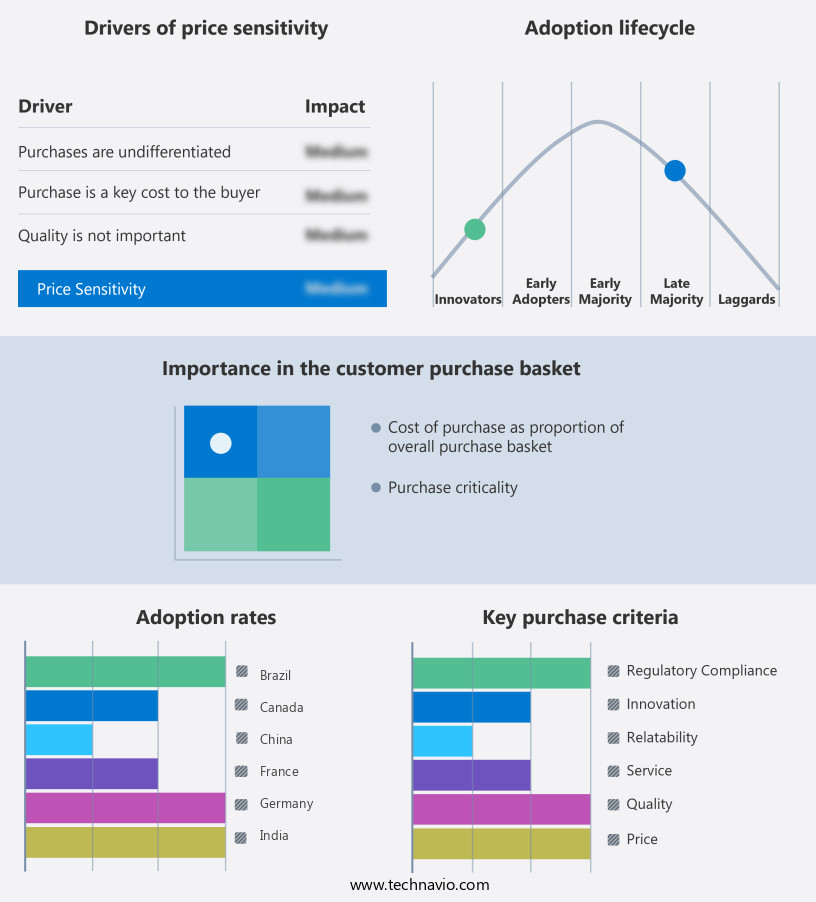
Customer Landscape of Green AI Infrastructure Industry
Competitive Landscape
Companies are implementing various strategies, such as strategic alliances, green ai infrastructure market forecast, partnerships, mergers and acquisitions, geographical expansion, and product/service launches, to enhance their presence in the industry.
Alibaba Group Holding Ltd. - This company specializes in eco-friendly AI infrastructure, providing cloud-based AI servers, advanced cooling systems, and sustainable data center solutions for Asian businesses and emerging tech firms. Their offerings prioritize energy efficiency and reduced environmental impact.
The industry research and growth report includes detailed analyses of the competitive landscape of the market and information about key companies, including:
- Alibaba Group Holding Ltd.
- Amazon.com Inc.
- CoreWeave
- Dell Technologies Inc.
- Equinix Inc.
- Fujitsu Ltd.
- Google LLC
- Graphcore Ltd.
- Hewlett Packard Enterprise Co.
- Huawei Technologies Co. Ltd.
- Intel Corp.
- International Business Machines Corp.
- Meta Platforms Inc.
- Microsoft Corp.
- NVIDIA Corp.
- Samsung Electronics Co. Ltd.
- Schneider Electric SE
- Siemens AG
- SK hynix Co. Ltd.
- Tata Consultancy Services Ltd.
Qualitative and quantitative analysis of companies has been conducted to help clients understand the wider business environment as well as the strengths and weaknesses of key industry players. Data is qualitatively analyzed to categorize companies as pure play, category-focused, industry-focused, and diversified; it is quantitatively analyzed to categorize companies as dominant, leading, strong, tentative, and weak.
Recent Development and News in Green AI Infrastructure Market
- In January 2024, Microsoft announced the launch of its new "Green-GPT" service, which uses custom-designed AI servers powered by hydroelectric energy and carbon-neutral data centers to reduce the carbon footprint of artificial intelligence applications (Microsoft Press Release).
- In March 2024, IBM and Google joined forces to develop an open-source, energy-efficient AI chip named "GreenWave-AI," aiming to decrease the energy consumption of AI infrastructure by up to 90% (IBM Press Release).
- In April 2025, NVIDIA secured a strategic partnership with Tesla to integrate AI infrastructure into Tesla's electric vehicle manufacturing process, with plans to reduce the carbon footprint of AI computing by 75% through the use of renewable energy sources (NVIDIA Press Release).
- In May 2025, Amazon Web Services (AWS) announced a significant investment of USD2 billion in renewable energy projects to power their data centers, aiming to reach 100% renewable energy usage by 2026 (AWS Press Release). These developments underscore the growing emphasis on green AI infrastructure and the commitment of major players to reduce the environmental impact of AI computing.
Dive into Technavio’s robust research methodology, blending expert interviews, extensive data synthesis, and validated models for unparalleled Green AI Infrastructure Market insights. See full methodology.
|
Market Scope
|
|
Report Coverage
|
Details
|
|
Page number
|
250
|
|
Base year
|
2024
|
|
Historic period
|
2019-2023 |
|
Forecast period
|
2025-2029
|
|
Growth momentum & CAGR
|
Accelerate at a CAGR of 28.4%
|
|
Market growth 2025-2029
|
USD 14652.5 million
|
|
Market structure
|
Fragmented
|
|
YoY growth 2024-2025(%)
|
26.7
|
|
Key countries
|
US, China, Germany, India, Canada, UK, Japan, France, Brazil, and South Korea
|
|
Competitive landscape
|
Leading Companies, Market Positioning of Companies, Competitive Strategies, and Industry Risks
|
Request Free Sample
Research Analyst Overview
- The market continues to evolve, driven by the integration of IoT devices and the implementation of predictive maintenance models across various sectors. Precision agriculture systems, for instance, have seen significant growth as farmers leverage AI-powered sensors to optimize water usage and enhance crop yield by up to 20%. This trend extends to data center optimization, where energy efficiency metrics and environmental impact assessments are crucial in reducing greenhouse gas emissions. Cloud computing platforms and edge computing deployment play a pivotal role in this market, enabling real-time monitoring systems and drone-based monitoring for efficient resource management. Green building certification, smart grids integration, and sustainable infrastructure design are also gaining traction as businesses strive for carbon footprint reduction and circular economy principles.
- AI-powered sensors, machine learning algorithms, and natural language processing systems are essential tools in this evolving landscape, contributing to the optimization of energy usage and the improvement of soil health. Renewable energy sources, such as solar and wind, are increasingly integrated into these systems, further reducing reliance on traditional energy sources. As the market continues to unfold, cybersecurity protocols and life cycle assessment become crucial components, ensuring sustainable material sourcing and minimizing waste reduction strategies. The industry anticipates a robust growth of over 15% in the coming years, driven by the integration of AI in various applications and the adoption of deep learning applications for resource management systems.
What are the Key Data Covered in this Green AI Infrastructure Market Research and Growth Report?
-
What is the expected growth of the Green AI Infrastructure Market between 2025 and 2029?
-
What segmentation does the market report cover?
-
The report is segmented by Product (AI optimized servers, Energy efficient cooling systems, High performance storage and memory solutions, and Renewable energy integration components), End-user (Cloud service providers, Enterprises, Government, and Research institutions and AI startups), Deployment (Cloud based, Hybrid and edge-computing environments, and On premises), and Geography (North America, APAC, Europe, South America, and Middle East and Africa)
-
Which regions are analyzed in the report?
-
North America, APAC, Europe, South America, and Middle East and Africa
-
What are the key growth drivers and market challenges?
-
Who are the major players in the Green AI Infrastructure Market?
-
Alibaba Group Holding Ltd., Amazon.com Inc., CoreWeave, Dell Technologies Inc., Equinix Inc., Fujitsu Ltd., Google LLC, Graphcore Ltd., Hewlett Packard Enterprise Co., Huawei Technologies Co. Ltd., Intel Corp., International Business Machines Corp., Meta Platforms Inc., Microsoft Corp., NVIDIA Corp., Samsung Electronics Co. Ltd., Schneider Electric SE, Siemens AG, SK hynix Co. Ltd., and Tata Consultancy Services Ltd.
Market Research Insights
- The market for green AI infrastructure continues to advance, integrating technologies such as waste heat recovery, network optimization, water recycling methods, server virtualization, environmental monitoring, yield forecasting models, sensor network deployment, material lifecycle tracking, software-defined networking, data center cooling, supply chain transparency, automated data collection, algorithm accuracy testing, renewable energy integration, energy storage solutions, plant health diagnostics, precision farming techniques, smart city initiatives, satellite imagery analysis, sustainability reporting, resource allocation algorithms, building energy modeling, eco-friendly construction, smart irrigation scheduling, network security monitoring, soil carbon sequestration, and nutrient management strategies.
- According to recent industry reports, the market is projected to grow by over 20% annually, driven by increasing demand for energy efficiency and sustainability in AI applications. For instance, a leading technology provider reported a 30% reduction in energy consumption through the implementation of advanced cooling systems and server optimization techniques.
We can help! Our analysts can customize this green ai infrastructure market research report to meet your requirements.
Get in touch
1 Executive Summary
- 1.1 Market overview
- Executive Summary - Chart on Market Overview
- Executive Summary - Data Table on Market Overview
- Executive Summary - Chart on Global Market Characteristics
- Executive Summary - Chart on Market by Geography
- Executive Summary - Chart on Market Segmentation by Product
- Executive Summary - Chart on Market Segmentation by End-user
- Executive Summary - Chart on Market Segmentation by Deployment
- Executive Summary - Chart on Incremental Growth
- Executive Summary - Data Table on Incremental Growth
- Executive Summary - Chart on Company Market Positioning
2 Technavio Analysis
- 2.1 Analysis of price sensitivity, lifecycle, customer purchase basket, adoption rates, and purchase criteria
- Analysis of price sensitivity, lifecycle, customer purchase basket, adoption rates, and purchase criteria
- 2.2 Criticality of inputs and Factors of differentiation
- Overview on criticality of inputs and factors of differentiation
- 2.3 Factors of disruption
- Overview on factors of disruption
- 2.4 Impact of drivers and challenges
- Impact of drivers and challenges in 2024 and 2029
3 Market Landscape
- 3.1 Market ecosystem
- Parent Market
- Data Table on - Parent Market
- 3.2 Market characteristics
- Market characteristics analysis
4 Market Sizing
- 4.1 Market definition
- Offerings of companies included in the market definition
- 4.2 Market segment analysis
- 4.4 Market outlook: Forecast for 2024-2029
- Chart on Global - Market size and forecast 2024-2029 ($ million)
- Data Table on Global - Market size and forecast 2024-2029 ($ million)
- Chart on Global Market: Year-over-year growth 2024-2029 (%)
- Data Table on Global Market: Year-over-year growth 2024-2029 (%)
5 Historic Market Size
- 5.1 Global Green AI Infrastructure Market 2019 - 2023
- Historic Market Size - Data Table on Global Green AI Infrastructure Market 2019 - 2023 ($ million)
- 5.2 Product segment analysis 2019 - 2023
- Historic Market Size - Product Segment 2019 - 2023 ($ million)
- 5.3 End-user segment analysis 2019 - 2023
- Historic Market Size - End-user Segment 2019 - 2023 ($ million)
- 5.4 Deployment segment analysis 2019 - 2023
- Historic Market Size - Deployment Segment 2019 - 2023 ($ million)
- 5.5 Geography segment analysis 2019 - 2023
- Historic Market Size - Geography Segment 2019 - 2023 ($ million)
- 5.6 Country segment analysis 2019 - 2023
- Historic Market Size - Country Segment 2019 - 2023 ($ million)
6 Five Forces Analysis
- 6.1 Five forces summary
- Five forces analysis - Comparison between 2024 and 2029
- 6.2 Bargaining power of buyers
- Bargaining power of buyers - Impact of key factors 2024 and 2029
- 6.3 Bargaining power of suppliers
- Bargaining power of suppliers - Impact of key factors in 2024 and 2029
- 6.4 Threat of new entrants
- Threat of new entrants - Impact of key factors in 2024 and 2029
- 6.5 Threat of substitutes
- Threat of substitutes - Impact of key factors in 2024 and 2029
- 6.6 Threat of rivalry
- Threat of rivalry - Impact of key factors in 2024 and 2029
- 6.7 Market condition
- Chart on Market condition - Five forces 2024 and 2029
7 Market Segmentation by Product
- 7.1 Market segments
- Chart on Product - Market share 2024-2029 (%)
- Data Table on Product - Market share 2024-2029 (%)
- 7.2 Comparison by Product
- Chart on Comparison by Product
- Data Table on Comparison by Product
- 7.3 AI optimized servers - Market size and forecast 2024-2029
- Chart on AI optimized servers - Market size and forecast 2024-2029 ($ million)
- Data Table on AI optimized servers - Market size and forecast 2024-2029 ($ million)
- Chart on AI optimized servers - Year-over-year growth 2024-2029 (%)
- Data Table on AI optimized servers - Year-over-year growth 2024-2029 (%)
- 7.4 Energy efficient cooling systems - Market size and forecast 2024-2029
- Chart on Energy efficient cooling systems - Market size and forecast 2024-2029 ($ million)
- Data Table on Energy efficient cooling systems - Market size and forecast 2024-2029 ($ million)
- Chart on Energy efficient cooling systems - Year-over-year growth 2024-2029 (%)
- Data Table on Energy efficient cooling systems - Year-over-year growth 2024-2029 (%)
- 7.5 High performance storage and memory solutions - Market size and forecast 2024-2029
- Chart on High performance storage and memory solutions - Market size and forecast 2024-2029 ($ million)
- Data Table on High performance storage and memory solutions - Market size and forecast 2024-2029 ($ million)
- Chart on High performance storage and memory solutions - Year-over-year growth 2024-2029 (%)
- Data Table on High performance storage and memory solutions - Year-over-year growth 2024-2029 (%)
- 7.6 Renewable energy integration components - Market size and forecast 2024-2029
- Chart on Renewable energy integration components - Market size and forecast 2024-2029 ($ million)
- Data Table on Renewable energy integration components - Market size and forecast 2024-2029 ($ million)
- Chart on Renewable energy integration components - Year-over-year growth 2024-2029 (%)
- Data Table on Renewable energy integration components - Year-over-year growth 2024-2029 (%)
- 7.7 Market opportunity by Product
- Market opportunity by Product ($ million)
- Data Table on Market opportunity by Product ($ million)
8 Market Segmentation by End-user
- 8.1 Market segments
- Chart on End-user - Market share 2024-2029 (%)
- Data Table on End-user - Market share 2024-2029 (%)
- 8.2 Comparison by End-user
- Chart on Comparison by End-user
- Data Table on Comparison by End-user
- 8.3 Cloud service providers - Market size and forecast 2024-2029
- Chart on Cloud service providers - Market size and forecast 2024-2029 ($ million)
- Data Table on Cloud service providers - Market size and forecast 2024-2029 ($ million)
- Chart on Cloud service providers - Year-over-year growth 2024-2029 (%)
- Data Table on Cloud service providers - Year-over-year growth 2024-2029 (%)
- 8.4 Enterprises - Market size and forecast 2024-2029
- Chart on Enterprises - Market size and forecast 2024-2029 ($ million)
- Data Table on Enterprises - Market size and forecast 2024-2029 ($ million)
- Chart on Enterprises - Year-over-year growth 2024-2029 (%)
- Data Table on Enterprises - Year-over-year growth 2024-2029 (%)
- 8.5 Government - Market size and forecast 2024-2029
- Chart on Government - Market size and forecast 2024-2029 ($ million)
- Data Table on Government - Market size and forecast 2024-2029 ($ million)
- Chart on Government - Year-over-year growth 2024-2029 (%)
- Data Table on Government - Year-over-year growth 2024-2029 (%)
- 8.6 Research institutions and AI startups - Market size and forecast 2024-2029
- Chart on Research institutions and AI startups - Market size and forecast 2024-2029 ($ million)
- Data Table on Research institutions and AI startups - Market size and forecast 2024-2029 ($ million)
- Chart on Research institutions and AI startups - Year-over-year growth 2024-2029 (%)
- Data Table on Research institutions and AI startups - Year-over-year growth 2024-2029 (%)
- 8.7 Market opportunity by End-user
- Market opportunity by End-user ($ million)
- Data Table on Market opportunity by End-user ($ million)
9 Market Segmentation by Deployment
- 9.1 Market segments
- Chart on Deployment - Market share 2024-2029 (%)
- Data Table on Deployment - Market share 2024-2029 (%)
- 9.2 Comparison by Deployment
- Chart on Comparison by Deployment
- Data Table on Comparison by Deployment
- 9.3 Cloud based - Market size and forecast 2024-2029
- Chart on Cloud based - Market size and forecast 2024-2029 ($ million)
- Data Table on Cloud based - Market size and forecast 2024-2029 ($ million)
- Chart on Cloud based - Year-over-year growth 2024-2029 (%)
- Data Table on Cloud based - Year-over-year growth 2024-2029 (%)
- 9.4 Hybrid and edge-computing environments - Market size and forecast 2024-2029
- Chart on Hybrid and edge-computing environments - Market size and forecast 2024-2029 ($ million)
- Data Table on Hybrid and edge-computing environments - Market size and forecast 2024-2029 ($ million)
- Chart on Hybrid and edge-computing environments - Year-over-year growth 2024-2029 (%)
- Data Table on Hybrid and edge-computing environments - Year-over-year growth 2024-2029 (%)
- 9.5 On premises - Market size and forecast 2024-2029
- Chart on On premises - Market size and forecast 2024-2029 ($ million)
- Data Table on On premises - Market size and forecast 2024-2029 ($ million)
- Chart on On premises - Year-over-year growth 2024-2029 (%)
- Data Table on On premises - Year-over-year growth 2024-2029 (%)
- 9.6 Market opportunity by Deployment
- Market opportunity by Deployment ($ million)
- Data Table on Market opportunity by Deployment ($ million)
10 Customer Landscape
- 10.1 Customer landscape overview
- Analysis of price sensitivity, lifecycle, customer purchase basket, adoption rates, and purchase criteria
11 Geographic Landscape
- 11.1 Geographic segmentation
- Chart on Market share by geography 2024-2029 (%)
- Data Table on Market share by geography 2024-2029 (%)
- 11.2 Geographic comparison
- Chart on Geographic comparison
- Data Table on Geographic comparison
- 11.3 North America - Market size and forecast 2024-2029
- Chart on North America - Market size and forecast 2024-2029 ($ million)
- Data Table on North America - Market size and forecast 2024-2029 ($ million)
- Chart on North America - Year-over-year growth 2024-2029 (%)
- Data Table on North America - Year-over-year growth 2024-2029 (%)
- 11.4 APAC - Market size and forecast 2024-2029
- Chart on APAC - Market size and forecast 2024-2029 ($ million)
- Data Table on APAC - Market size and forecast 2024-2029 ($ million)
- Chart on APAC - Year-over-year growth 2024-2029 (%)
- Data Table on APAC - Year-over-year growth 2024-2029 (%)
- 11.5 Europe - Market size and forecast 2024-2029
- Chart on Europe - Market size and forecast 2024-2029 ($ million)
- Data Table on Europe - Market size and forecast 2024-2029 ($ million)
- Chart on Europe - Year-over-year growth 2024-2029 (%)
- Data Table on Europe - Year-over-year growth 2024-2029 (%)
- 11.6 South America - Market size and forecast 2024-2029
- Chart on South America - Market size and forecast 2024-2029 ($ million)
- Data Table on South America - Market size and forecast 2024-2029 ($ million)
- Chart on South America - Year-over-year growth 2024-2029 (%)
- Data Table on South America - Year-over-year growth 2024-2029 (%)
- 11.7 Middle East and Africa - Market size and forecast 2024-2029
- Chart on Middle East and Africa - Market size and forecast 2024-2029 ($ million)
- Data Table on Middle East and Africa - Market size and forecast 2024-2029 ($ million)
- Chart on Middle East and Africa - Year-over-year growth 2024-2029 (%)
- Data Table on Middle East and Africa - Year-over-year growth 2024-2029 (%)
- 11.8 US - Market size and forecast 2024-2029
- Chart on US - Market size and forecast 2024-2029 ($ million)
- Data Table on US - Market size and forecast 2024-2029 ($ million)
- Chart on US - Year-over-year growth 2024-2029 (%)
- Data Table on US - Year-over-year growth 2024-2029 (%)
- 11.9 China - Market size and forecast 2024-2029
- Chart on China - Market size and forecast 2024-2029 ($ million)
- Data Table on China - Market size and forecast 2024-2029 ($ million)
- Chart on China - Year-over-year growth 2024-2029 (%)
- Data Table on China - Year-over-year growth 2024-2029 (%)
- 11.10 Germany - Market size and forecast 2024-2029
- Chart on Germany - Market size and forecast 2024-2029 ($ million)
- Data Table on Germany - Market size and forecast 2024-2029 ($ million)
- Chart on Germany - Year-over-year growth 2024-2029 (%)
- Data Table on Germany - Year-over-year growth 2024-2029 (%)
- 11.11 India - Market size and forecast 2024-2029
- Chart on India - Market size and forecast 2024-2029 ($ million)
- Data Table on India - Market size and forecast 2024-2029 ($ million)
- Chart on India - Year-over-year growth 2024-2029 (%)
- Data Table on India - Year-over-year growth 2024-2029 (%)
- 11.12 Canada - Market size and forecast 2024-2029
- Chart on Canada - Market size and forecast 2024-2029 ($ million)
- Data Table on Canada - Market size and forecast 2024-2029 ($ million)
- Chart on Canada - Year-over-year growth 2024-2029 (%)
- Data Table on Canada - Year-over-year growth 2024-2029 (%)
- 11.13 UK - Market size and forecast 2024-2029
- Chart on UK - Market size and forecast 2024-2029 ($ million)
- Data Table on UK - Market size and forecast 2024-2029 ($ million)
- Chart on UK - Year-over-year growth 2024-2029 (%)
- Data Table on UK - Year-over-year growth 2024-2029 (%)
- 11.14 Japan - Market size and forecast 2024-2029
- Chart on Japan - Market size and forecast 2024-2029 ($ million)
- Data Table on Japan - Market size and forecast 2024-2029 ($ million)
- Chart on Japan - Year-over-year growth 2024-2029 (%)
- Data Table on Japan - Year-over-year growth 2024-2029 (%)
- 11.15 France - Market size and forecast 2024-2029
- Chart on France - Market size and forecast 2024-2029 ($ million)
- Data Table on France - Market size and forecast 2024-2029 ($ million)
- Chart on France - Year-over-year growth 2024-2029 (%)
- Data Table on France - Year-over-year growth 2024-2029 (%)
- 11.16 Brazil - Market size and forecast 2024-2029
- Chart on Brazil - Market size and forecast 2024-2029 ($ million)
- Data Table on Brazil - Market size and forecast 2024-2029 ($ million)
- Chart on Brazil - Year-over-year growth 2024-2029 (%)
- Data Table on Brazil - Year-over-year growth 2024-2029 (%)
- 11.17 South Korea - Market size and forecast 2024-2029
- Chart on South Korea - Market size and forecast 2024-2029 ($ million)
- Data Table on South Korea - Market size and forecast 2024-2029 ($ million)
- Chart on South Korea - Year-over-year growth 2024-2029 (%)
- Data Table on South Korea - Year-over-year growth 2024-2029 (%)
- 11.18 Market opportunity by geography
- Market opportunity by geography ($ million)
- Data Tables on Market opportunity by geography ($ million)
12 Drivers, Challenges, and Opportunity/Restraints
- 12.3 Impact of drivers and challenges
- Impact of drivers and challenges in 2024 and 2029
- 12.4 Market opportunities/restraints
13 Competitive Landscape
- 13.2 Competitive Landscape
- Overview on criticality of inputs and factors of differentiation
- 13.3 Landscape disruption
- Overview on factors of disruption
- 13.4 Industry risks
- Impact of key risks on business
14 Competitive Analysis
- 14.2 Company ranking index
- 14.3 Market positioning of companies
- Matrix on companies position and classification
- 14.4 Alibaba Group Holding Ltd.
- Alibaba Group Holding Ltd. - Overview
- Alibaba Group Holding Ltd. - Business segments
- Alibaba Group Holding Ltd. - Key news
- Alibaba Group Holding Ltd. - Key offerings
- Alibaba Group Holding Ltd. - Segment focus
- SWOT
- 14.5 Amazon.com Inc.
- Amazon.com Inc. - Overview
- Amazon.com Inc. - Business segments
- Amazon.com Inc. - Key news
- Amazon.com Inc. - Key offerings
- Amazon.com Inc. - Segment focus
- SWOT
- 14.6 Dell Technologies Inc.
- Dell Technologies Inc. - Overview
- Dell Technologies Inc. - Business segments
- Dell Technologies Inc. - Key news
- Dell Technologies Inc. - Key offerings
- Dell Technologies Inc. - Segment focus
- SWOT
- 14.7 Google LLC
- Google LLC - Overview
- Google LLC - Product / Service
- Google LLC - Key news
- Google LLC - Key offerings
- SWOT
- 14.8 Hewlett Packard Enterprise Co.
- Hewlett Packard Enterprise Co. - Overview
- Hewlett Packard Enterprise Co. - Business segments
- Hewlett Packard Enterprise Co. - Key news
- Hewlett Packard Enterprise Co. - Key offerings
- Hewlett Packard Enterprise Co. - Segment focus
- SWOT
- 14.9 Huawei Technologies Co. Ltd.
- Huawei Technologies Co. Ltd. - Overview
- Huawei Technologies Co. Ltd. - Product / Service
- Huawei Technologies Co. Ltd. - Key news
- Huawei Technologies Co. Ltd. - Key offerings
- SWOT
- 14.10 Intel Corp.
- Intel Corp. - Overview
- Intel Corp. - Business segments
- Intel Corp. - Key news
- Intel Corp. - Key offerings
- Intel Corp. - Segment focus
- SWOT
- 14.11 International Business Machines Corp.
- International Business Machines Corp. - Overview
- International Business Machines Corp. - Business segments
- International Business Machines Corp. - Key news
- International Business Machines Corp. - Key offerings
- International Business Machines Corp. - Segment focus
- SWOT
- 14.12 Meta Platforms Inc.
- Meta Platforms Inc. - Overview
- Meta Platforms Inc. - Business segments
- Meta Platforms Inc. - Key offerings
- Meta Platforms Inc. - Segment focus
- SWOT
- 14.13 Microsoft Corp.
- Microsoft Corp. - Overview
- Microsoft Corp. - Business segments
- Microsoft Corp. - Key news
- Microsoft Corp. - Key offerings
- Microsoft Corp. - Segment focus
- SWOT
- 14.14 NVIDIA Corp.
- NVIDIA Corp. - Overview
- NVIDIA Corp. - Business segments
- NVIDIA Corp. - Key news
- NVIDIA Corp. - Key offerings
- NVIDIA Corp. - Segment focus
- SWOT
- 14.15 Samsung Electronics Co. Ltd.
- Samsung Electronics Co. Ltd. - Overview
- Samsung Electronics Co. Ltd. - Business segments
- Samsung Electronics Co. Ltd. - Key news
- Samsung Electronics Co. Ltd. - Key offerings
- Samsung Electronics Co. Ltd. - Segment focus
- SWOT
- 14.16 Schneider Electric SE
- Schneider Electric SE - Overview
- Schneider Electric SE - Business segments
- Schneider Electric SE - Key news
- Schneider Electric SE - Key offerings
- Schneider Electric SE - Segment focus
- SWOT
- 14.17 Siemens AG
- Siemens AG - Overview
- Siemens AG - Business segments
- Siemens AG - Key news
- Siemens AG - Key offerings
- Siemens AG - Segment focus
- SWOT
- 14.18 SK hynix Co. Ltd.
- SK hynix Co. Ltd. - Overview
- SK hynix Co. Ltd. - Product / Service
- SK hynix Co. Ltd. - Key news
- SK hynix Co. Ltd. - Key offerings
- SWOT
15 Appendix
- 15.2 Inclusions and exclusions checklist
- Inclusions checklist
- Exclusions checklist
- 15.3 Currency conversion rates for US$
- Currency conversion rates for US$
- 15.4 Research methodology
- 15.7 Validation techniques employed for market sizing
- Validation techniques employed for market sizing
- 15.9 360 degree market analysis
- 360 degree market analysis
- 15.10 List of abbreviations







![]() Get the report (PDF) sent to your email within minutes.
Get the report (PDF) sent to your email within minutes.
Complimentary full Excel data with your report purchase.